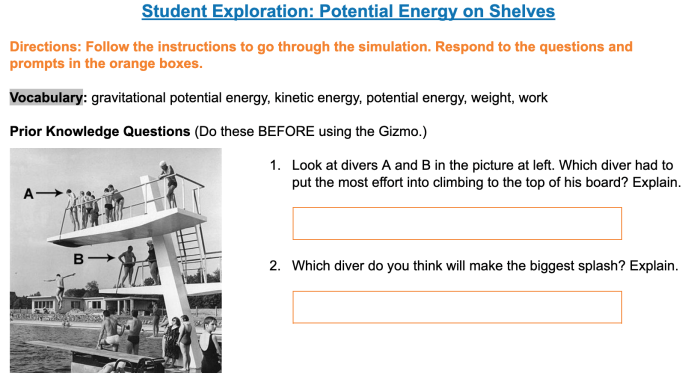Student exploration: potential energy on shelves takes center stage in this comprehensive exploration, unraveling the captivating world of potential energy and its implications on objects resting on shelves. As we delve into this realm, we’ll uncover the factors that influence potential energy, methods for its measurement, and real-world scenarios that illustrate its dynamic nature.
Prepare to be enlightened as we navigate the fascinating terrain of potential energy on shelves.
This discourse will delve into the concept of potential energy, exploring its relevance to objects on shelves. We will examine the factors that influence potential energy, such as height, mass, and position. Additionally, we will discuss methods for measuring potential energy, providing examples of calculations to determine the potential energy of objects on shelves.
Understanding Potential Energy on Shelves: Student Exploration: Potential Energy On Shelves

Potential energy is a form of energy stored within an object due to its position or condition. In the context of shelves, potential energy is associated with objects placed on shelves at a certain height above the ground.
Factors influencing the potential energy of objects on shelves include:
- Height: The higher an object is placed on a shelf, the greater its potential energy.
- Mass: The heavier an object, the greater its potential energy.
- Position: The position of an object on a shelf can also affect its potential energy. For example, an object placed near the edge of a shelf has a higher potential energy than an object placed closer to the center.
Measuring Potential Energy on Shelves
The potential energy of an object on a shelf can be measured using the following formula:
PE = mgh
where:
- PE is the potential energy in joules (J)
- m is the mass of the object in kilograms (kg)
- g is the acceleration due to gravity (9.8 m/s² on Earth)
- h is the height of the object above the ground in meters (m)
For example, a 1 kg book placed on a shelf 1 meter above the ground has a potential energy of 9.8 J.
Exploring Potential Energy Changes on Shelves
Objects on shelves can gain or lose potential energy through various actions.
- Lifting an object onto a shelf increases its potential energy.
- Lowering an object from a shelf decreases its potential energy.
- Stacking objects on a shelf increases the potential energy of the objects on the bottom.
- Moving an object from one shelf to another can change its potential energy depending on the height difference between the shelves.
Safety Considerations, Student exploration: potential energy on shelves
Objects on shelves pose potential hazards if not stored properly.
- Objects placed too high or near the edge of a shelf can fall and cause injury or damage.
- Overloading shelves with heavy objects can cause them to collapse.
To minimize potential energy risks, follow these guidelines:
- Store heavy objects on lower shelves.
- Place objects evenly distributed across the shelf.
- Avoid placing objects near the edge of a shelf.
- Secure shelves to walls or other structures to prevent them from tipping.
Applications of Potential Energy on Shelves
Understanding potential energy on shelves has practical applications in everyday life.
- Optimizing storage space: Knowing the potential energy of objects can help determine the best way to store them on shelves, maximizing space while ensuring safety.
- Preventing accidents: Understanding potential energy hazards can help prevent accidents caused by falling or tipping objects.
FAQ
What is potential energy?
Potential energy is the energy possessed by an object due to its position or condition. In the context of shelves, potential energy refers to the energy an object has due to its height above the ground.
How can I measure the potential energy of an object on a shelf?
The potential energy of an object on a shelf can be measured using the formula: Potential energy = mass × gravity × height. Mass is measured in kilograms, gravity is a constant value of 9.8 m/s², and height is measured in meters.
What factors affect the potential energy of an object on a shelf?
The potential energy of an object on a shelf is affected by three main factors: mass, height, and position. The greater the mass or height of an object, the greater its potential energy. Additionally, the position of an object on a shelf can also affect its potential energy, as objects at higher positions have greater potential energy than objects at lower positions.